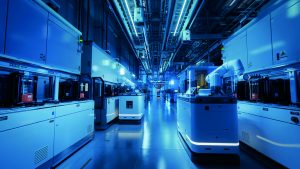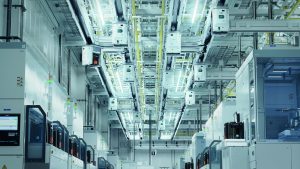
AI systems have acquired their capabilities through learning, fuelled by training on vast amounts of data. This ongoing revolution prompts the question: what is the next frontier to be conquered? Beyond the novel consumer applications the implications of AI in specialised fields such as semiconductor manufacturing are equally profound.
The range of applications in which AI can enable automation and increase efficiency is immense, from informing capital allocation to demand forecasting, fab layout planning and chip design. Semiconductor manufacturing has been identified as the function presenting the most attractive opportunities, where the potential savings have been calculated to be over $10bn in the next few years.
Impact at all levels
The semiconductor industry is facing several challenges where AI can make a significant impact. These span key activities, for example, long-term capacity planning, research and design, sales, procurement and manufacturing.
There are some use cases that are increasingly gaining traction. One is supply chain optimisation, where predictive analytics can forecast demand, optimise inventory levels and enhance the overall efficiency of the supply chain.
Another is automatic material handling systems (AMHS). Using AI-driven cognitive robotics within AMHS automates material transportation throughout a plant, optimising production planning.
AI can predict when equipment is likely to fail or require maintenance. This predictive maintenance reduces downtime and increases overall equipment efficiency.
Another use case is defect detection, whereby advanced image recognition algorithms can identify defects in wafers at an early stage, ensuring higher yields and reducing waste.
In virtual metrology, AI can be deployed to estimate a product’s quality directly from production process data. This enables real-time quality monitoring without additional measuring steps.
In process control applications AI can analyse vast amounts of data to optimise the process, ensuring the best conditions for each step and improving the overall quality of the chips (for example, tool matching).
Automating scheduling
A long-standing challenge of intelligence that broadly aligns with the context of semiconductor applications is: intelligence is the ability to accomplish complex goals.
Intelligence is not universal, but depends on the defined goal and, as such, there are many possible types of intelligence. It can be characterised according to goals, for example, technical (problem solving), social (interaction), or creative (idea generation).

It can also be defined by skill level, which can be below/equivalent/super-human level. This determines whether we aim to match the performance of a human or surpass it.
Another goal is scope. Narrow intelligence specialises in a specific task, while broad intelligence encompasses a wide range of tasks, such as human intelligence.
There is also autonomy, whereby intelligence can operate with varying degrees of independence from human-guided to fully autonomous.
Scheduling the production of wafer fab is a well-defined technical problem that involves thousands of constraints, including product routes, timelink restrictions, complex processing times, and unbalanced recipe enablements across similar tools in a tool group. This requires super-human performance levels in algorithms to sift through billions or even trillions of candidate solutions to derive optimal decisions, while adhering to complex constraints. For narrow and complex problems, AI can greatly surpass human intelligence The technical nature of the task requires high autonomy and removing the need for human intervention is desired in such a dynamic environment.
Three facets of AI
AI involves creating models and machines that mimic human intelligence, including learning, reasoning and decision-making.
Learning is an important aspect of AI, relying on a model’s ability to iteratively refine its internal parameters until it can accurately capture underlying patterns. Machine learning is the cornerstone approach for learning from data. Techniques range from simple models such as linear regression to complex deep learning networks.
Reasoning involves drawing inferences based on established rules and facts, mimicking the human ability to logically connect information. It can aid in tasks such as medical diagnosis or legal case analysis.
Decision-making encompasses action exploration and problem-solving. Action exploration deals with determining actions through interaction with an environment, which can vary from well-defined scenarios such as a chess game to unstructured situations such as driving a car. Problem-solving, on the other hand, focuses on finding solutions to clearly defined problems with specific objectives and constraints. This can involve simple tasks such as sorting or more intricate challenges such as route planning, resource allocation and scheduling. Optimisation and mathematical programming are often employed in these contexts.
AI for production scheduling
Production scheduling involves making optimal choices to co-ordinate resources, tasks and time to meet production goals. It requires handling well-defined parameters and constraints, along with specific objectives such as maximising throughput or achieving on-time delivery. As such, it is best suited to rigorous and well-structured AI methods that focus on optimal and feasible decision-making such as mathematical programming.

It can involve some aspects of learning and reasoning as well. Learning can be useful when some of the parameters are not well defined or static. For example, estimating transfer times between different locations of a fab may depend on various parameters, necessitating the use of a prediction model that has learned from past data. In terms of reasoning, a good decision-making approach should allow some degree of introspection from the user. Contrary to black box approaches, such as deep neural networks, mathematically formal methods such as mixed integer linear programming (MILP) enable transparency and explainability.
Characteristics of AI techniques
Optimality refers to the ability of an AI technique to reach and prove that the true optimal solution has been found. In a complex environment, such as a semiconductor fab where small improvements can have significant cost or time implications.
Feasibility is about ensuring that the solution abides by the constraints of the problem, for example machine capacity, human resources and time windows. An AI solution must respect these constraints while optimising the schedule.
Speed is crucial in the dynamic environment of semiconductor manufacturing, therefore the selected AI technique must be able to provide fast and accurate solutions to adapt to these changing conditions.
Explainability is the ability of an AI technique to provide insights into how it arrived at a given solution. In a high stakes environment, such as a semiconductor fab, explainability helps build trust in the system, enables troubleshooting and allows for more effective human-AI collaboration.
Flexibility or applicability across a wide range of possible scenarios and system changes highlights the capability of an AI method to be fully autonomous, requiring minimal human supervision and intervention. This quality is indispensable, especially as complexity grows and specialised personnel are spread thinner across other functions.
Different AI techniques fare differently on these dimensions. Rule-based systems offer high explainability and feasibility levels, but may lack optimality, especially in complex scenarios. Unforeseen changes in a fab’s state may require rule adjustments or even entirely new ones, affecting flexibility. Heuristic approaches can provide acceptable solutions quickly, but typically cannot provide optimality or feasibility guarantees. Reinforcement learning can potentially offer high levels of optimality and speed, but at the cost of explainability, the risk of infeasibility and the need for extensive tuning.
In contrast, mathematical programming techniques, such as MILP, can provide guaranteed feasibility, while the distance to true optimality can be easily computed. They offer explainability in terms of how decisions are made based on the objective function and constraints. Although computational complexity can be an issue, they can greatly benefit from advanced decomposition methods and are complemented by heuristic methods.
Mathematical programming techniques’ deterministic nature and the rigour of their mathematical foundations make them a reliable and robust choice for complex operational problems.
Going beyond with AI
Today, AI in semiconductor manufacturing stands at a critical point. With the increasing complexity of semiconductor processes and the escalating demand for efficiency and quality, the need for effective AI solutions has never been greater.
As we progress into the era of AI-driven manufacturing, the nuanced roles of different AI techniques will become more and more apparent. Machine-learning approaches bring novel capabilities for learning and predicting from data: yield improvement and predictive maintenance are very promising paths. When it comes to autonomously and reliably scheduling and planning operations in a fab an exact optimisation approach, such as MILP, becomes the key to unlocking peak performance.
 Electronics Weekly Electronics Design & Components Tech News
Electronics Weekly Electronics Design & Components Tech News



